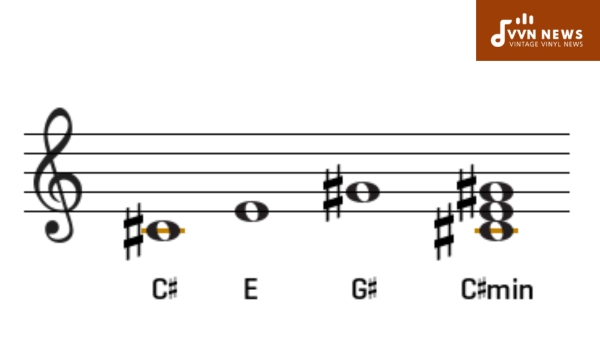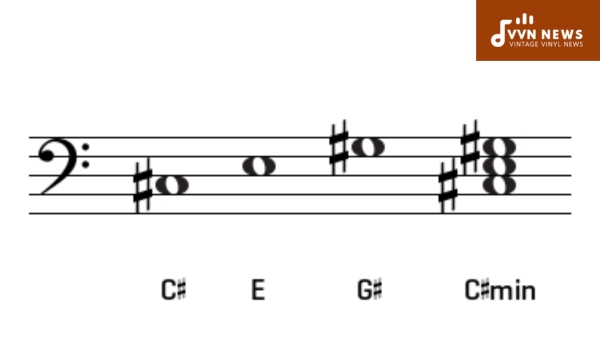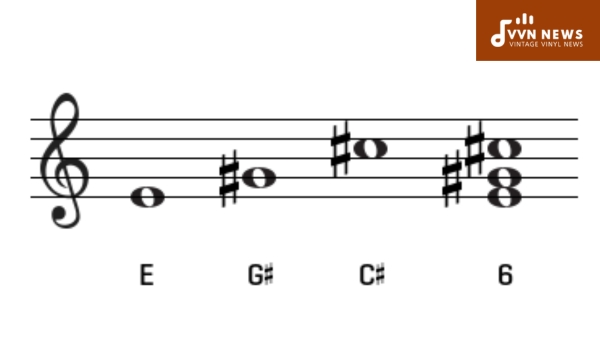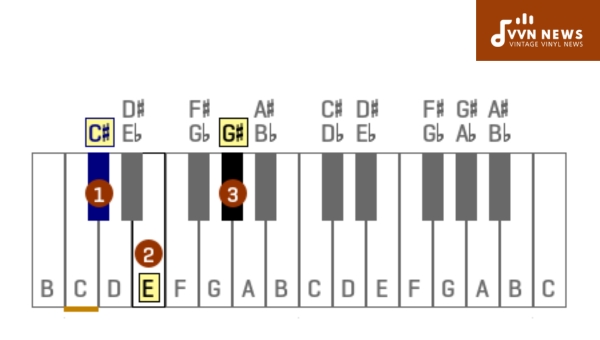When browsing through my library of musical elements, one particularly stands out – the C sharp minor triad.
It may seem like just three simple notes to the untrained ear, but this triad packs a powerful and emotive punch that resonates across the various genres of music.
Before you can fully appreciate its impact though, it’s essentially crucial to understand its underlying structure.
The C sharp minor triad might sound complex, but it’s relatively straightforward once you delve into its mechanics.
A triad consists of three notes – namely, the root note or tonic (C# in this case), the third (E), and the fifth note (G#) based on the scale of C# minor.
This triad is inherently versatile with each note adding a distinctive angle that illustrates just how beautifully intricate even simplistic elements can be in music.
What is a C Sharp Minor Triad?
A C sharp minor triad is a three-note chord consisting of the notes C#, E, and G#. It is derived from the C# natural minor scale, which contains the following notes: C#, D#, E, F#, G#, A, B.
The triad is built by taking the first (C#), third (E), and fifth (G#) notes of this scale. It follows a minor chord structure characterized by a root note, a minor third above the root, and a perfect fifth above the root.
The C# minor triad offers a melancholic and somber sound, often associated with feelings of sadness, introspection, and depth.
It is widely used in various genres such as classical music, jazz, rock, and pop to create emotional impact within compositions.
To effectively utilize the C sharp minor triad in musical composition or performance, it’s crucial to explore its construction and various playing techniques on different instruments.
How Do You Construct a C Sharp Minor Triad?
Constructing a C sharp minor triad involves identifying the root note (C#) and using intervals to determine the other two notes. Here’s a step-by-step breakdown of how to construct this triad:
- Start with the root note: The root note of a C sharp minor triad is C#. This serves as the foundation for the chord.
- Determine the minor third interval: To find the second note, you need to go up three half steps from the root note. In this case, you would play an E.
- Find the perfect fifth interval: Next, you’ll find the perfect fifth interval by going up seven half steps from the root note. In this case, it will be G#.
Once you have located these three notes – C#, E, and G# – you have successfully constructed a C sharp minor triad.
To gain practical experience with playing this chord on different instruments, such as guitar or piano, it’s helpful to familiarize yourself with where these notes are located on each instrument’s respective fretboard or keyboard.
Also Read: C Sharp Major Pentatonic Scale [Crisp & Clear Tones For Your Music]
How Can You Play a C Sharp Minor Triad on Various Instruments?

Mastering the C sharp minor triad on different instruments opens up a world of possibilities for musicians. Here’s how you can play this triad on some common instruments:
Piano/Keyboard:
- Position your hands on the keyboard with your left hand in the lower range and your right hand in the higher range.
- Place your thumb (1st finger) on C# below middle C, your middle finger (3rd finger) on E, and your pinky (5th finger) on G#. This represents the root position of the C# minor triad.
- To play different inversions of the triad, rearrange the order of the notes while maintaining their spacing of a minor third and perfect fifth.
Guitar:
- On the guitar, locate the root note of C#.
- Place your index finger across all strings at fret 4 to barre and hold down all three required notes at once.
- Your index finger should press down strings 1, 2, and 3 at fret 4 to play C# while playing open strings for E and G#.
Violin/Cello:
- For violinists, place your first finger on A string (second position) at note F#, which is equivalent to G#.
- Use your second or third finger for the D string at note B, and use either the second or fourth finger for the G string at note E.
Keep in mind that these instructions are just starting points; exploring different octaves or even experimenting with additional harmonies can create unique sounds using the C sharp minor triad.
What Are the Different Inversions of a C Sharp Minor Triad?
In music theory, an inversion refers to rearranging the positions of the notes within a chord. By changing the order of the notes, we can create different voicings and textures while still maintaining the same triadic structure. Let’s dive into the different inversions of the C# minor triad:
- Root Position: In the root position, the root note (C#) is at the bottom, followed by E, and then G# on top. This is the most basic and common form of the C# minor triad.
- First Inversion: In the first inversion, we take the third note (E) and move it an octave higher. The new arrangement becomes E as the lowest note, followed by G#, and then C#. This inversion offers a different tonal character with a higher register for E as its bass note.
- Second Inversion: The second inversion involves taking both the root note (C#) and moving it an octave higher than its original positions within the chord. The structure becomes G# at the bottom, followed by C#, and then E on top. This inversion creates a unique bass-heavy sound.
By familiarizing yourself with these inversions, you gain greater flexibility in chord progressions and open up avenues for harmonic exploration within your compositions.
What are The Triads of C Sharp Minor Triad?

A triad is a three-note chord formed by stacking thirds on top of each other. In the context of the C sharp minor triad, several triads can be formed using the notes from the C# minor scale. Let’s explore each of these triads and their characteristics:
1. C# Minor Triad
The C# minor triad is the basic triad derived directly from the C# natural minor scale. It consists of the notes C#, E, and G#.
As mentioned earlier, this triad creates a sad and somber sound, evoking emotions of sadness and depth.
2. D# Diminished Triad
The D# diminished triad is formed by taking the second note (D#) of the C# natural minor scale as the root and stacking thirds on top of it.
The resulting notes are D#, F#, and A. Diminished triads have a tense, unresolved quality to them, making them suitable for creating tension in the music.
3. E Major Triad
The E major triad is constructed by taking the third note (E) of the C# natural minor scale as the root and adding two more notes in the third interval above it.
The resulting notes are E, G#, and B. Unlike all previous triads, an E major triad introduces a more uplifting and bright sound to compositions.
4. F# Minor Triad
The F# minor triad is formed by taking the fourth note (F#) of the C# natural minor scale as the root note and adding two more notes in thirds above it.
The resulting notes are F#, A, and C#. This gives a darker yet slightly different tonality compared to when using the basic C sharp minor chord.
Also Read: A Sharp Minor Pentatonic Scale [Unique Harmonic Possibilities]
5. G# Minor Triad
The G# minor triad is created by taking the fifth note (G#) of the C# natural minor scale as the root and adding two more notes in thirds above it.
The resulting notes are G#, B, and D#. This triad offers a unique sound, with hints of tension and sadness.
6. A Major Triad
The A major triad is constructed by taking the sixth note (A) of the C# natural minor scale as the root and stacking two more notes in thirds above it. The resulting notes are A, C#, and E. This triad brings a sense of brightness and is often used to create an uplifting atmosphere.
7. B Major Triad
Finally, the B major triad is formed by taking the seventh note (B) of the C# natural minor scale as the root and adding two more notes in thirds above it.
The resulting notes are B, D#, and F#. This triad introduces a vibrant quality to compositions and can serve as a contrasting element when combined with other chords.
These different triads within the context of the C sharp minor scale open up numerous possibilities for creating unique chord progressions, melodies, and harmonies in music compositions.
Incorporating these various triads allows composers to evoke different moods and further explore their musical expression.
How to Master C Sharp Minor Triad Inversions on Guitar and Piano?
Mastering the inversions of the C sharp minor triad on the guitar and piano opens up a world of possibilities for creating unique chord progressions and exploring different musical textures.
In this section, we will explore step-by-step instructions to help you navigate through these inversions seamlessly.
Guitar
- Root Position: Start with the root position triad by placing your index finger on the 9th fret of the low E string (C#), middle finger on the 10th fret of the A string (E), and ring finger on the 11th fret of the D string (G#).
- First Inversion: To play the first inversion, move your index finger to the 9th fret of the A string (E), ring finger to the 11th fret of the D string (G#), and pinky finger to the 12th fret of the G string (C#).
- Second Inversion: For the second inversion, place your index finger on the 9th fret of the D string (G#), your middle finger on the 10th fret of the G string (C#), and your ring finger on the 11th fret B string (E).
Piano
- Root Position: Starting with your right hand, place your thumb on C#, middle finger on E, and pinky finger on G#. Play these notes simultaneously or one after another.
- First Inversion: Shift your hand so that your thumb is now playing E, the middle finger plays G#, and the pinky plays C#. This rearrangement creates a first inversion.
- Second Inversion: Shift again so that your thumb plays G#, your middle finger plays C#, and pinky plays E. This arrangement represents a second inversion.
By practicing these inversions in various keys, you’ll develop a strong foundation for incorporating the C sharp minor triad into your playing and composing.
Experiment with different chord progressions and explore the unique sounds that these inversions bring to your music.
Also Read: G Sharp Minor Pentatonic Scale [Add Dimension To Your Music]
Popular Songs featuring the Use of C Sharp Minor Triad

The C sharp minor triad has made its mark across various genres of music, and its distinctive sound can be heard in several popular songs. Let’s explore some notable examples:
- “Candle in the Wind” by Elton John: This iconic ballad features the C# minor chord prominently throughout the song, adding a touch of melancholy to its emotional lyrics.
- “Angie” by The Rolling Stones: The opening guitar chords of this classic rock song revolve around the C# minor triad, contributing to its haunting and introspective atmosphere.
- “No Woman, No Cry” by Bob Marley: This reggae anthem utilizes the C# minor triad in its chorus, creating a sense of longing and introspection that perfectly complements Marley’s heartfelt lyrics.
- “Unchained Melody” by The Righteous Brothers: This timeless love ballad features the C# minor triad prominently during its emotional crescendos, intensifying the feelings of longing and desire expressed in the lyrics.
- “Bring Me to Life” by Evanescence: In this alternative rock hit, the C# minor triad is used extensively to create an intense and dark atmosphere that mirrors the song’s powerful vocals.
- “Landslide” by Fleetwood Mac: Stevie Nicks’ heartfelt ode to reflection and growth showcases the C# minor chord during key moments, evoking a sense of vulnerability and emotional depth.
- “Hello” by Adele: Adele’s soulful ballad heavily relies on the use of the C# minor triad, reinforcing her emotive vocals with chords that convey deep sadness and longing.
- “Still Got The Blues (For You)” by Gary Moore: This blues-infused rock masterpiece features rich guitar solos that often incorporate the C# minor triad, infusing the song with a sense of raw emotion and heartfelt expression.
These songs serve as excellent examples of how the C# minor triad can be used to evoke specific emotions and create a captivating musical experience.
By analyzing and studying their utilization of this chord structure, musicians and songwriters can gain insights into how to leverage its power in their compositions.
Also Read: C Sharp Minor Pentatonic Scale [Add Color To Your Solos & Riffs]
FAQs About C Sharp Minor Triad
How do you play a C sharp minor triad on the piano?
To play a C sharp minor triad on the piano, place your right thumb on C#, your middle finger on E, and your pinky finger on G#. This configuration creates the harmonious sound of the triad.
Can I use a C sharp minor triad in any genre of music?
Absolutely! The versatility of the C# minor triad allows it to be used in a wide variety of genres, including classical, jazz, rock, pop, and more. Its emotive qualities make it an excellent choice for evoking specific emotions within a piece.
Are there different inversions of the C sharp minor triad?
Yes, there are three inversions of the C# minor triad: first inversion (E-G#-C#), second inversion (G#-C#-E), and root position (C#-E-G#). Each inversion has a unique sound and can be used to add variation and interest to musical compositions.
What are some popular chord progressions featuring the C sharp minor triad?
A commonly used chord progression involving C# minor is the classic I-VI-IV-V progression. This progression includes chords such as C#m-G#m-F#m-B. Other popular progressions include ii-V-I or vi-V-I in various keys, where the vi chord is substituted with its relative major’s tonic chord.
Can you provide examples of popular songs that feature the use of a C sharp minor triad?
Certainly! Some well-known songs that prominently utilize the C sharp minor triad include “Someone Like You” by Adele (intro and verses) and “Creep” by Radiohead (chorus). These songs beautifully showcase how the C# minor triad can create emotional impact and contribute to a memorable musical experience.
Conclusion
The C sharp minor triad is a powerful and expressive chord structure that adds depth and emotion to music compositions.
Its construction and characteristics, musicians can harness its melancholic nature to convey different moods and evoke specific emotions.
Whether you’re a composer, songwriter, or performer, incorporating the C sharp minor triad into your musical repertoire can elevate your compositions and captivate listeners.
So, embrace this captivating chord structure and let its haunting beauty captivate your musical journey.








